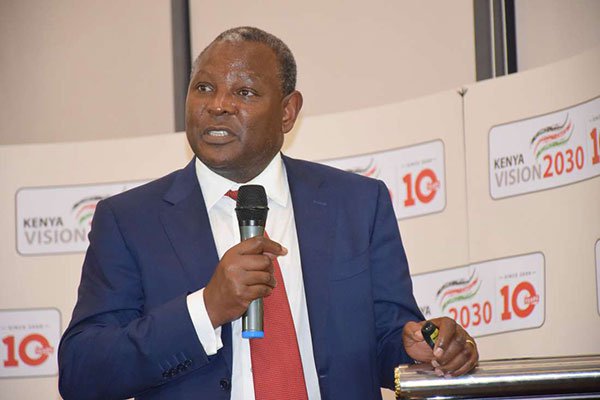Vision 2030 Delivery Board Chairman James Mwangi addresses a business community at English Point Marina in Mombasa on August 9, 2018. PHOTO | FILE | NATION MEDIA GROUP Rights without responsibility is Kenya’s worst dilemma, fuelling a smouldering liberal activism now fuelling resistance to taxation to fund development.
Making corruption an expensive affair will force Kenyans to chose not to be corrupt. But the long-term sustainability of the war on corruption depends on a skilful balancing of hard power and soft power approaches.
In the aftermath of the China-Africa Summit in Beijing last week, a vexed “debt trap” casts a dark shadow over Kenya’s Vision 2030, the country’s development blueprint.
Launched a decade ago in June 2008, the Vision has steered the country to unprecedented heights. But uncertainty looms even larger over the funding of the grandiose Vision for the remaining 12 years.
The country is caught between the rock and the hard place. On the one extreme is a palpable popular resistance to taxation as a source of domestic funding.
On the other extreme is a vociferous and ideologically inspired resistance to the inflow of external aid particularly from China.
Even worse, a decayed national value system has plunged the country into a corruption trap, siphoning public resources to private use.
TRANSFORMING KENYA
Upon coming to power in 2002, President Mwai Kibaki’s National Rainbow Coalition (NARC) government realised that the dream of defeating the evil trinity of poverty, ignorance and disease remained unrealised.
In response, the government adopted Kenya Vision 2030 to transform Kenya into a “newly industrialising, upper middle-income country providing a high quality of life to all its citizens by 2030 in a clean and secure environment”.
A decade later, the country has edged closer to becoming industrialised. “With 12 years to go, we are excited and appreciate that much has been achieved under Vision 2030,” Dr James Mwangi, the Chairman of Vision 2030 Delivery Board, said.Kenya’s economy has expanded from a GDP of Ksh1.3 trillion in 2002 to Ksh7.8 trillion in 2017, with its GDP per capita expanding from Ksh27,000 to Ksh166,000. INFRASTRUCTURE PROGRESS Its paved road network has expanded from 8,938 kilometers to 11,796. A Standard Gauge Railway from Mombasa to Nairobi has been completed at a cost of Ksh327 billion. The Nairobi-Naivasha stretch is ongoing at a cost of Ksh150 billion.The country’s electric power has grown from 1,142 MW to 2,264 MW, increasing its capacity to power industrialization […]
